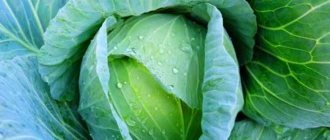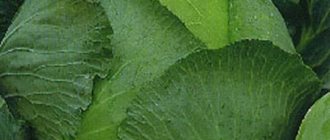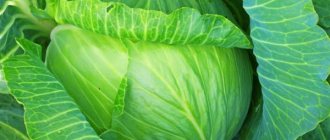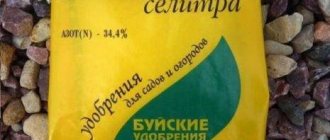“Stone Head” is a variety of white cabbage with a long ripening period
The homeland of the variety is Poland.
They began to grow it in Russia at the end of the 20th century. Since then it has proven itself well. In 2006, it was entered into the state register with some recommendations for cultivation. Thus, in areas with an unfavorable climate, it is recommended to grow in greenhouse conditions, and in the central and southern zone of Russia - in open ground.
The content of the article:
1. Description of the variety 2. Advantages and disadvantages 3. Growing the cabbage variety Stone Head 4. Preparing cabbage seeds before planting 4.1 Preparing the soil before planting 4.2 Planting cabbage for seedlings 4.3 Picking seedlings 4.4 Preparing the land on the site 4.5 Planting seedlings in open ground 5. Rules caring for cabbage Stone head 5.1 How to water cabbage 5.2 Feeding white cabbage 5.3 Loosening cabbage 5.4 Hilling 5.5 Weeding 5.6 How to deal with pests and diseases 6. Reviews about cabbage Stone head
Optimal growing time
The described variety can be grown using seedlings or planted directly in an open garden bed. The optimal time for sowing seedlings is from April 10. Strong shoots are transferred to open beds at the end of May.
The optimal time for planting seeds in unprotected soil without first growing seedlings is April 20–25. This method is only suitable for southern regions with warm climates. Cultivation is carried out under film.
Did you know? After heat treatment, the amount of ascorbic acid in white cabbage increases. The fact is that ascorbigen, which is part of the vegetable, turns into ascorbic acid when heated.
Cabbage “Stone Head” variety description
Initially, the Stone Head variety was created for cultivation purposes for industrial production. The only important condition was to obtain an unpretentious cabbage variety with high yields, good immunity and resistance to pests.
As already noted, the Stone Head cabbage belongs to varieties with late ripening periods
. The fruits reach full maturity 3.5-5 months after planting the cabbage seeds. Different producers of the Stone Head variety indicate different harvest ripening times.
The bushes have an average height, the maximum possible height is half a meter. The diameter of the plant's rosette is about 50 cm.
Cabbage Stone Head - photo
All cabbage leaves are directed upward and have a soft green, light color. If you look closely, you can see a bluish tint. The leaves are pressed tightly against the fork and are shaped like a circle, with wavy edges. The main core, located in the center, is elastic and consists of hard fibers. The leaves have a waxy coating that creates a glossy effect.
The shape of the head of cabbage is round. The structure is dense. The average weight of the fetus reaches 4.5-5 kg. The Stone Head cabbage forks are green on top and white on the inside.
On a note!
The composition contains a high content of glucose, and therefore there is no bitterness at all. The taste characteristics of the Stone Head cabbage variety are excellent.
Stone Head is a full-fledged variety, not a hybrid, and therefore its seeds can be used for breeding
. All signs and characteristics of the parent plant are preserved.
The yield of the Stone Head cabbage variety is at a high level when the crop is properly cared for and reaches 11 kg per 1 m2
.
The fruits of this variety are used both for industrial production, grown in large areas and for home use.
The Stone Head variety is excellent for long-term storage, as well as pickling and sauerkraut.
Cabbage Stone Head - video
Diseases and prevention
The “Sugarloaf” variety gets sick very rarely, but with poor care or in an unsuitable place of growth it can get sick.
Clubroot is a disease that affects the root system of a plant.
To prevent such a disease, it is very important to plant this crop every year in a new place. Another important factor is timely weeding.
Vascular bacteriosis appears on the leaves of the vegetable. The leaves begin to turn yellow and the veins become dark in color. To prevent disease, you need to buy high-quality seeds from trusted stores, regularly weed the beds and treat the plant against harmful insects.
Fusarium very often develops on a plant in hot weather. This fungal disease can affect the entire plant so that it cannot be saved. The only way out is to dig up the diseased vegetable and destroy it.
The soil where such cabbage grew should be treated with a solution of copper sulfate. To prevent disease on healthy plants, they can be sprayed with the drug “Immunodeficiency” from time to time.
To get rid of the cruciferous flea beetle, which likes to feed on cabbage leaves, you need to periodically spray the plants with an ash solution.
Advantages and disadvantages of the variety
For many years, the Stone Head cabbage variety has been a leader due to its advantages.
These include:
- frost resistance;
- the ability to produce a good harvest in any climatic conditions, as well as in open and closed ground;
- excess or lack of moisture does not have any effect on the appearance of the heads of cabbage or their taste;
- The storage period for Stone Head cabbage is more than 6 months, while the taste and nutrients are preserved;
- no special care is required, the most important thing for normal development is a sufficient amount of light;
- high immunity, protecting against damage by pests and diseases;
- consistency of harvest;
- possibility of use for industrial production;
- great taste.
Among the disadvantages, it is worth noting the rigidity of the structure of the leaves located at the top, increased demands on the soil composition and amount of light.
Advantages and disadvantages
Most of the characteristics that cabbage received from its “parents” brought the variety incredible popularity.
Main advantages:
- Versatility of use in the kitchen along with high taste.
- Cabbage can withstand hot, dry weather without damage.
- A sudden cold snap does not affect the formation of a head of cabbage.
- During long-term transportation, cabbage does not get crushed or crack.
- Dense heads of cabbage are stored until the end of winter. At the same time, the taste only improves.
- Cabbage is not a hybrid. At home, it is possible to obtain fruits and high-quality planting material.
Excessive rigidity of the leaves is noted as a disadvantage.
Cabbage "Stone Head" variety cultivation
To obtain healthy and strong plants that produce a decent harvest of tasty and juicy heads of cabbage, you will need to properly prepare cabbage seedlings for planting. This method helps protect the crop from exposure to low temperatures, as well as achieve a high level of seed germination.
Preparing cabbage seeds before planting
Seeds can be purchased at the store or collected yourself. In case of independent selection, they are carefully sorted and processed for disinfection purposes. Seeds smaller than 1.5 mm in size are suitable for sowing.
After healthy seeds are sorted, they are soaked in warm water. The water should be heated to a temperature of approximately +40 to +50 degrees. After soaking in warm water, place it in cold water. It is important to thoroughly dry the seeds before planting, first treating them with one of the fungicides. Fitosporin-M, Trichodermin, Gamair are suitable. The solution is prepared at the rate of 1 tablet per 1 liter of water. Soaking time from 8 to 18 hours.
Attention!
When seeds are purchased from a specialized store, the need for selection and treatment against fungus is eliminated. They have already gone through all stages of processing from the manufacturer.
Soaking seeds in warm and cold water is necessary to stimulate growth so that they germinate faster.
Preparing the soil before planting
It is imperative to prepare the soil. You can purchase a suitable enriched substrate from a specialty store. Please read the packaging carefully. It must be marked “For growing seedlings.”
Vegetable growers with experience prefer to make the soil themselves. The simplest and most popular way is to mix peat and sand in equal proportions.
There are several more options for preparing soil for planting cabbage seedlings:
- peat + sand + turf soil (in proportions 75:5:20, proportions are indicated as percentages);
- sand + peat + turf (5:75:20);
- humus + turf + peat + compost (in equal proportions) and add a little sand.
Place soil in a layer 3 to 4 cm thick into the container selected for seedlings and level it. Moisturize by adding Alerin-B solution or Gamair. Quantity: 2 tablets per 10 liters of water. The soil should be kept for 24 to 72 hours.
Planting Stone Head cabbage for seedlings
Make furrows to a depth of 1 cm, maintaining a distance of 3 cm between them.
. Stone head cabbage seeds are placed in the furrows, with a mandatory distance of 1 - 1.5 cm. Sprinkle with earth on top. The temperature should be from 18 to 20 degrees above 0. Wait for sprouts to appear. As a rule, they form on the 4-5th day. When the sprouts “hatch”, the temperature is reduced to 7–9 degrees above 0. After a week, the seedlings are planted in separate small pots. The diameter should be no more than 6–8 cm.
Picking cabbage seedlings Stone head
Cabbage sprouts are planted in soil of the same composition as for germination. Just add double superphosphate, based on st. spoons per 1 bucket of mixture, add 2 tbsp. spoons of ash.
Suitable soil designed specifically for planting cabbage crops.
Cabbage varieties!
Kohlrabi Giant Kolobok Kohlrabi
After picking, the sprouts are placed for a couple of days in a temperature range of 17 to 18 degrees above zero
. To prevent the appearance of blacklegs, sand is sprinkled on top of the soil. After settling into a new place, the temperature is slightly reduced to 14 degrees. At night - until 10.
Good to know!
An important condition for normal development is a sufficient amount of sunlight. When the weather is cloudy, artificial light is used.
Fertilizing cabbage seedlings Stone head should be applied when a couple of leaves appear on the plant
(inorganic fertilizer). Two weeks before planting in a permanent place of growth, hardening of the seedlings begins, taking them out into the open every day. The time the seedlings spend in the fresh air is increased gradually. Sometimes during this period, fertilizing with a special solution is carried out in parallel. It consists of urea and potassium sulfate (in the amount of 1 tablespoon) and 10 liters of water.
Preparing the land on the site
The most suitable soil for growing cabbage is loamy soil with a neutral pH. The soil is prepared in the fall. Digging is carried out using humus, compost, and manure.
In spring, mineral fertilizers are needed.
To do this, mix superphosphate, urea, and wood ash in equal proportions. If fertilizing was not applied to the soil in the autumn, it is worth applying fertilizer from humus (500 grams), ash (1/2 cup), and nitroammophoska (a teaspoon) at the very beginning of spring.
When choosing a planting site, be sure to take into account the crops that were previously cultivated in this area.
GOOD TO KNOW!
How to properly plant cabbage seedlings
The best precursors for cabbage plants are
:
- tomatoes;
- turnip;
- beet;
- cucumbers;
- garlic;
- legumes
Planting cabbage seedlings "Stone Head" in open ground
To transplant, the sprouts must be healthy and strong. The height of the stem is at least 15 cm. The number of full leaves is at least 5.
Planting cabbage in open ground - video
Stone head cabbage is transplanted using the transshipment method, that is, together with an earthen lump
. Planting holes are made slightly larger than the size of the roots. The planting depth is carried out to the bottom leaves. Plant seedlings in the absence of sun, preferably on a cloudy day. Between plants it is necessary to leave a distance of 45 to 50 meters. A distance of 50-55 cm should be maintained between cabbage rows. Young plants must be protected from sunlight.
Attention!
It is worth changing the place where cabbage is planted every two years. This will help maintain yields at the same level and reduce the likelihood of disease and pest damage.
Reviews
Stone head is an old, time-tested variety. That’s why reviews online are mostly positive. There are, however, some small tips on agricultural technology and storage.
Marina, Voronezh region
Stone head grows well. The heads of cabbage are large and dense. Stores wonderfully. But sometimes the germination rate of seeds of this variety is low. In order for them to sprout perfectly, I always soak them in a soda solution. To a glass of hot water (50-60 degrees) I add a teaspoon of baking soda without top. And I leave it for a day! Then I strain and dry the seeds on paper. On the same day I plant seedlings in cups. Try it, you will like it!
Rules for caring for cabbage “Stone Head”
Caring for Stone Head cabbage includes standard procedures
:
- watering;
- soil fertilization;
- loosening;
- weeding;
- prevention from pests and diseases.
How to water cabbage
After planting the seedlings, watering is carried out immediately. The soil is moistened 3 to 4 times a week. One plant requires 2 to 3 liters of water.
While the Stone Head cabbage seedlings are not yet strong, they are watered in this mode. After the plants have adapted, watering is reduced to once a week. This happens after about 25 - 30 days. For 1 m2, 10 to 12 liters of liquid are required.
Photo of cabbage Stone head
Drip irrigation and furrow irrigation are best suited. The water should be warm (temperature at least 18 degrees). Otherwise, a fungal infection may occur.
Feeding white cabbage “Stone Head”
In one season, cabbage requires 3 to 4 feedings.
.
The first one is carried out 2 weeks after planting at a permanent place of growth
. At this time, it is recommended to apply nitrogen fertilizers. “Sudarushka”, “Effecton” (calculated at 10 grams per 10 liters of water) are suitable.
The 2nd is held 10 days after the 1st
. At this stage, the composition of the fertilizer is as follows: saltpeter, superphosphate, potassium chloride (1:2:1). For m2 you will need from 40 to 60 grams of mixture.
3rd feeding is carried out with a potassium-phosphorus mixture
.
4th is carried out in the fall, in August,
using fertilizers “Autumn”, diammo-nitrophoska.
Useful article:
The best varieties of late cabbage for long-term storage
Loosening cabbage
Be sure to carry out after moistening the soil, keeping it for a day after watering or natural moisture through precipitation. The depth of loosening is 7 cm. When systematically loosening cabbage plantings, a dense earth crust will not form on the soil surface, which will ensure access of air and water to the root system of the plant.
Hilling cabbage
Required for the growth and development of roots on the sides.
Hilling cabbage Stone head is carried out a couple of times:
- 20 days after planting at a permanent place of growth;
- 10 – 12 days after the first procedure.
Attention
: it is necessary to pour heaps of earth onto the stem.
Weeding
Regular procedure. Weeding cabbage should be done carefully so as not to damage the roots. It is important to remove weeds in a timely manner, as they take nutrients from the plant, thereby disrupting normal development and growth, which may not have the best effect on the harvest.
How to deal with cabbage pests and diseases
To prevent the occurrence of diseases, as well as pest damage, the following prevention is required:
Interesting!
Marjoram: popular varieties
Mandatory digging of the soil before planting cabbage in a permanent place of growth with the removal of weeds. This will prevent the occurrence of larvae.
Timely hilling and weeding to prevent moisture stagnation.
Plants that feed “beneficial” insects or entomophages should be planted near the place where cabbage grows.
During the active action of pests and parasites, cabbage is treated with special means: Fitoverm, Karbofos, Iskra, Metaldehyde.
Homemade preparations!
Recipes for making salted cabbage
“Stone Head” cabbage is a late-ripening variety that is resistant to low temperatures
. Can grow in any climate conditions. Suitable for commercial purposes as cultivation for sale. In cooking they are used both fresh and processed. A good choice for any vegetable grower.
Popular varieties for pickling
It is necessary to choose the best varieties for canning, taking into account that the heads of cabbage are juicy and sweet. Dutch Langedijker is also suitable for this, but there is still a lot of bitterness in it after the crops are harvested from the fields.
But among the late varieties of vegetables, those that are saturated with sugars are suitable for pickling:
The characteristics of the Kolobok hybrid include excellent taste, high content of useful elements, vitamins, and long-lasting shelf life of the hybrid. The top of the Kolobok cabbage is covered with dark green leaves, like those of the Langedijker variety, which fit tightly to each other. And the weight of the forks is average, a little more than four kilograms - convenient for cutting for pickling. Kolobok cabbage produces yields of up to ten to twelve kilograms per square meter. Late Moscow cabbage has been popular since the thirties of the 20th century. The dense, round heads of cabbage can reach ten kilograms if weather conditions and proper care permit. The variety grows well in any climate, withstanding sudden temperature changes. Due to the sweetness and juiciness of the leaves, this variety is chosen for pickling. The Moscow late 9 variety has similar characteristics. But the forks are slightly smaller – weighing up to four kilograms. It is much more convenient to ferment them than large ones. Therefore, this variety of Moscow late is chosen for canning. There is no need to rush to ferment cabbage Sugar Loaf. It tastes a little bitter after cleaning. But after a month, the forks gain sweetness, and it’s time for canning. Reviews of Sugarloaf cabbage say that this is one of the sweet late varieties of cabbage. There is no bitterness in it, there is a lot of ascorbic acid. When grown, the yield of marketable products is more than ninety percent. Thanks to reviews of Sugarloaf cabbage, this variety is most common among summer residents. Of the late varieties, one cannot fail to mention Crumont cabbage, which reaches technical maturity 120 -130 days after emergence
It is important to note the advantage of small heads of cabbage in the high content of calcium, iron salts, vitamin A and C. It is these substances that the human body lacks in winter.
Late cabbage varieties are chosen by gardeners to provide themselves with vitamins throughout the winter.
Cabbage Stone Head: reviews of the variety
Vladimir, 54 years old, Saratov region We have been growing the Stone Head variety for 5 years now. We are very pleased: the agricultural technology is simple, the harvest is good. My wife makes pickles and pickles. The leaves, of course, are a little harsh when fresh. After processing it is not felt. The Stone Head variety is suitable for cultivation in any part of the country.
Margarita, 38 years old, Irkutsk I really love vegetables, they are always on my table. I grow it myself in my garden. Among them there is, of course, cabbage. I chose the Kolobok and Kamennaya Golova varieties, as they grow well and produce a good harvest even in a harsh continental climate. I confirm this fact. In the first year I received a good harvest of 10 kg per 1 m2. The stone head is great for pickling, and can be stored in the basement for more than six months. For those who like to not only eat, but also grow vegetables, like me, I recommend it! And also for novice vegetable growers.
Recently searched:
Harvest and storage
The following recommendations for harvesting will help increase the shelf life of heads of cabbage and preserve their beneficial and tasteful qualities.
The harvest is harvested at the end of September or beginning of October, when the air temperature drops to +5°C and the weather is dry. The head of cabbage is cut with a sharp knife so that the height of the stump is about 12 cm.
The remains with roots are removed and burned.
Storage features and keeping quality of the Stone Head variety
For long-term storage, the heads of cabbage are placed in a cellar with a temperature from 0°C to +5°C, good ventilation and humidity of at least 90-95%. The cabbage is laid out in wooden boxes or wrapped in cling film.
In addition to this type of storage, the vegetable is suitable for freezing and pickling. The keeping quality of the variety is excellent, since it retains its properties for 8 months or more.
Features of the plant, consumer qualities
The height of an adult plant reaches approximately 40 cm, the rosette of leaves is raised above the soil surface, powerful, rather spreading, with a diameter of about 80 cm. The leaves are light gray-green in color, covered with a medium waxy coating, large in size, with a slightly bubbly surface and slightly wavy edges. The head of cabbage is partially covered, has a round shape, weight in the range of 2.2-2.8 kg (according to the originator - 3-3.5 kg). The outer stump is of medium length, the inner one is short, about 7 cm. When cut, the head of cabbage is almost white, tightly packed: density – 4.1 points out of 5 possible.
The cross-sectional photo clearly shows the dense structure and small size of the internal stump
The vegetable is characterized by a high sugar content and excellent taste. Intended for fresh consumption, preparing hot dishes, perfect for fermentation.
Cabbage is a valuable source of biologically active substances and has properties beneficial to the human body. The leaves accumulate a whole complex of vitamins - C, B1, B2, B3, P, PP, K1, U. 100 grams of raw product contains an average of 35 to 50 mg of ascorbic acid (vitamin C), which is partially preserved even during heat treatment . Studies have shown that after cooking for 60 minutes, about 50% ascorbic acid remains in cabbage, and some of it goes into the broth. The daily requirement of vitamin C for adults is approximately 75-90 mg, that is, it is enough to include 200-300 g of fresh or sauerkraut in the daily diet.
Description of plants
An amazing fact - this variety does not come from Russia at all, but from Poland. It is very popular, widespread and well-known; for more than ten years it has been officially included in the “State Register of Plants Recommended for Growing in Russia.”
In fact, Stone Head is a white cabbage variety. In terms of ripening time, it is average. An average of 126 days pass from planting to technical ripeness - naturally, this period is approximate and can vary depending on the climatic conditions of a particular region and the weather conditions of a particular season.
The bushes are beautiful and regular. The outer and outer leaves of this variety are very rich, juicy green. They are small in size and seem to be slightly concave inward. A characteristic feature is the presence of a waxy coating. The leaves that form the cabbage itself are dark green, but when they grow they become lighter.
Pest and disease control
To prevent the appearance and subsequent spread of insects, it is recommended to follow a number of measures:
- Before planting a crop on a permanent bed, dig up the area and remove the weeds along with the roots. This measure will help get rid of overwintering larvae.
- As the cabbage grows, make sure that there is no stagnation of moisture near the root system. To do this, the vegetable is hilled and the rows are periodically loosened.
- Slugs are collected manually and armyworm clutches are destroyed.
- Near the cabbage growing season, plants are planted on which entomophagous insects feed.
During the period when there is an invasion of parasites, cabbage is treated with microbiological contact agents “Fitoverm” and “Lipidocid”. During precipitation with insecticides: “Karbofos”, “Iskra” against caterpillars, “Metaldehyde” against slugs.
Difference from other species
The Sugarloaf cabbage variety has a number of differences from other types:
- high content of vitamins;
- effectiveness in cosmetic procedures; cabbage leaves are added to various face masks;
- accelerates tissue healing;
- stimulates thyroid function;
- removes waste and toxins from the body;
- used in the prevention of various diseases;
- infusions from the Sugarloaf cabbage variety are used as mouth rinses;
- contains almost all microelements of the periodic table: phosphorus, iodine, sodium, potassium, calcium, iron;
- the composition contains useful substances such as thiamine, riboflavin, folic and ascorbic acid;
- low calorie content;
- The presented variety of cabbage can be stored for 9 months.
Want to know about the best cabbage varieties? Read about varieties such as Kolobok, Slava, Zimovka, Amager, Moscow late, Centurion F1, Nozomi, Valentina and Podarok.
Fruit characteristics
Stone head is characterized by rather large fruits - their weight can even reach six kilograms. They are very dense in texture. The inner leaves have excellent characteristics - they are tender, thin and have no thick veins at all. Inside the head of cabbage, like all varieties of cabbage, there is a stump, but it is small. But as for the outer one, on the contrary, it is thick and can easily withstand the weight of the cabbage.
The shape of the heads of cabbage is usually more or less regular, flattened. The variety is considered high-yielding - with proper agricultural technology and favorable conditions, even up to 10 kilograms of fruit can be harvested from one square meter.
Features of agricultural technology
The white cabbage variety Stone Head is a cold-resistant, light- and moisture-loving crop. In the risky farming zone it is grown by seedlings; in the southern regions it can be sown in the ground.
Growing seedlings
Since the variety is late-ripening, seedlings should be planted in April-May. The greenhouse is prepared in advance. Compost is placed in it, and fertile soil with sand is placed on top. The soil is poured with boiling water, and potassium permanganate is added for greater effect. This microelement works in two directions: it disinfects the soil and provides additional nutrition.
Make furrows in the cooled soil and sow white cabbage seeds at a distance of two to three centimeters. According to agrotechnical standards, 3-4 grams of seeds will be required per square meter of seedling.
Comment! When sowing seeds without seedlings, from 0.15 to 2 grams are needed per square meter.
Before sowing, cabbage seeds of this variety, if they do not have a special protective shell, are disinfected in a light pink solution of potassium permanganate. Then it is dried to a powdery state.
Note! Potassium permanganate kills spores of the most dangerous disease on seeds - blackleg.
With any method, the seeds are buried in the soil by about one and a half centimeters. With more immersion of seeds in the soil, germination time is delayed. Sometimes they may not rise at all. Experienced gardeners recommend pollinating cabbage seedlings and soil with dry wood ash after the first leaf appears. Caring for seedlings is simple. Mainly watering and loosening. There is no need to moisten the soil too much, otherwise the roots may rot.
If necessary, seedlings are planted in separate pots. In this case, the root system grows better.
Planting seedlings in the ground
When the seedlings grow to 15 centimeters and have 5 or 6 leaves, you can plant them in open ground.
Comment! White cabbage with 5-6 leaves is not afraid of single night frosts down to -5 degrees.
Seedlings of the Stone Head cabbage variety need to be planted early so that they have time to take root well before the cabbage fly begins in summer. As a rule, in May-June the soil warms up to 10 degrees. Many gardeners rely on the sowing calendar. This is even welcome. Since climatic conditions in Russia vary, it is necessary to take into account the peculiarities.
It is very important to choose the right plot of garden. According to agrotechnical standards, it is better to plant any varieties of white vegetables in beds where legumes, eggplants, and onions grew
Not a bad harvest yield after pumpkin and zucchini. Tomatoes, cucumbers, and parsley should not be planted next to Stone Head cabbage. These crops are demanding on nutrition; they will draw out all the juices from the ground, but cabbage will get nothing.
The soil for seedlings is fertilized before planting. It is better not to use fresh manure, as it may contain helminths. Compost, rotted manure or peat are used as organic matter. Among mineral fertilizers, preference is given to superphosphate.
The holes are made according to the pattern 50x60 or 70x70, preferably in a checkerboard pattern. Seedlings of white cabbage Stone head are planted in two rows to facilitate further care.
Wood ash is added to each hole and poured with boiling water. When the ground has cooled, seedlings are planted. The lower cotyledon leaves are torn off. The seedlings are buried down to the first true leaf. If the plant “drags” down after watering, it must be lifted immediately.
If frosts are expected in the forecast, the planted cabbage seedlings can be covered with film or agrofibre. Planting is done in the evening so that the plants have time to recover from stress overnight.










